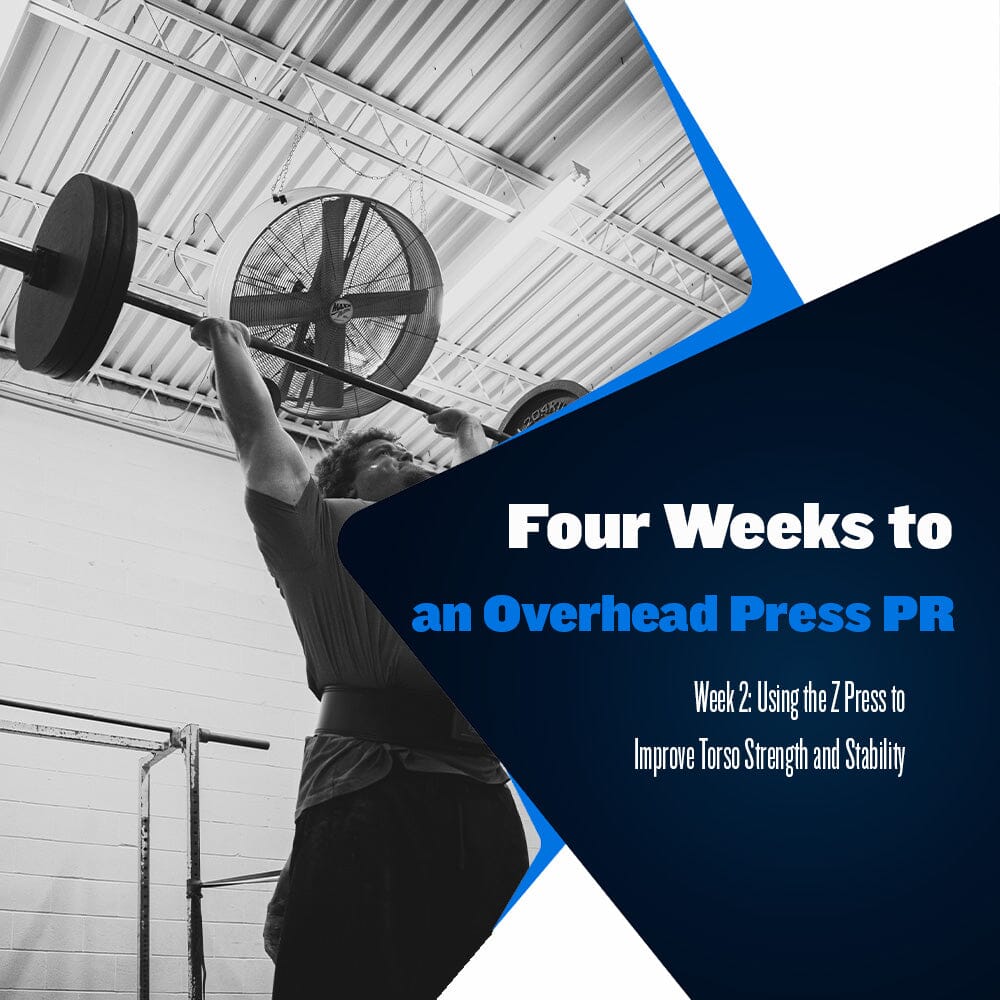Four Weeks to an Overhead Press PR: Week 2

No matter what sport an athlete prepares for, having a strong upper body is critical to high-level sports performance. When following a Conjugate Method training plan, it is recommended to use both the bench and overhead press to improve upper body strength and muscle mass. In this case, the goal is to design a four-week max-effort upper training plan to achieve an overhead press PR lift.
It is now week two of the four-week plan. Last week, the strict press was the main exercise of the day, performed for a top set of five repetitions. While most max effort training is spent training between 1-3 repetitions, using top sets of five reps can be an excellent way to build absolute strength while challenging work capacity with barbell weights around 75-80%.
While less beneficial than a heavy set of 1-3 reps, the top set of five will still recruit large motor units, especially as fatigue sets in during the set. Typically, the last few reps will recruit even larger motor units.
Without further delay, here is week two of the four-week plan to achieve an overhead press PR lift:
Main Exercise
Athletes will perform the Z press for a max-effort top-set single this week. Much like the floor press is a beneficial lift to improve the bench press, the Z press is a great lift to improve overhead press ability. With leg drive removed from the equation, the athlete must use the trunk and torso to move the weight.
This results in the trunk, mid/upper back, triceps, and shoulders doing much of the work. The Z press will teach an athlete how to properly brace, stabilize, and use the upper torso when pressing weight overhead.
When setting this exercise up, the athlete should be seated in a squat rack, with the weight elevated so that the barbell sits on the upper chest during unrack. It may be necessary to have side spotters hand the weight to the athlete if the pin height doesn’t allow the athlete to unrack the barbell themselves.
As the athlete takes the barbell out of the rack, the trunk, mid, and upper back must be braced and locked in position. Maintaining rigid positioning is vital to prevent poor posture from leading to a missed lift or potential injury. With the torso properly braced and engaged, the athlete will use the upper back, shoulders, and triceps to press the barbell off the chest to lockout.
If unracking the barbell becomes an issue, performing this exercise Anderson-style from pins or safety straps is possible. This can especially benefit beginner and intermediate athletes who may initially struggle with the Z press.
Accessory Exercises
Similar to last week, we will continue focusing on the anterior and posterior shoulders, pecs, back, biceps, triceps, and forearms. As mentioned, these muscle groups are the primary targets during upper-body accessory training. No matter how big or strong an athlete may be, these muscle groups must be properly trained each week.
Here is the accessory exercise programming for week two:
Standing DB Overhead Press - 4 x 8-10
Skullcrushers - 4 x 10-12
Chest-Supported Rows - 4 x 10-12
Cable Pressdowns - 3 x 12-15
DB Bicep Curls - 3 x 12-15
Lateral Raises - 3 x 12-15
Accessory training weights should be the heaviest weight an athlete can lift while completing all prescribed sets and reps with safe and proper form. This does not mean lifting the absolute heaviest weight possible. This means using working weights that challenge the athlete during every set.
One of the biggest mistakes many athletes make is performing accessory exercises too lightly. Without the proper training intensity, the body fails to react to the input, and there is limited to no positive training adaptation achieved. If an athlete is going to spend time doing the work, the work must be useful.
Training at proper intensity levels with optimal form will only lead to faster gains in strength and skill in the various lifts. Failure to do so will lead to slow improvement and unpreparedness that can result in injury in the future.
Execution and Intent
Two things I mention frequently in many of the articles I write is intent and execution. No matter how great a method is or how well the training is programmed, failure to execute the training with the correct intent is a surefire way to fail. Success in the gym is affected by many things, but none more than the intent and execution of an athlete.
If an athlete can get those two things right, there is no doubt training will bring about athletic improvement and transfer to sport without issue. If the training is not taken seriously and the exercises are performed without focus, all the athlete will do in the long run is make themselves tired and increase the likelihood of injury.
When performing max effort exercises, always focus on executing at the highest level of perfection from the first warmup rep to the max attempt. All athletes should aim to gain the strength and coordination to become machine-like in their execution. Taking these steps to master exercise execution reduces the risk of injury and amplifies the benefits of max effort training.
Sources:
Simmons, L. (2007). Westside Barbell Book of Methods. Westside Barbell.
Verkhoshansky, Y., & Siff, M. C. (2009). Supertraining. Verkhoshansky.





